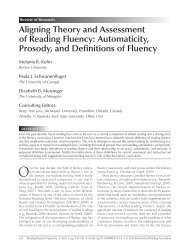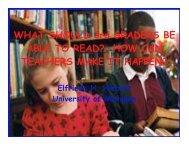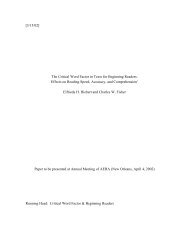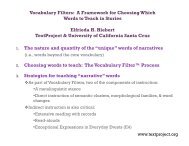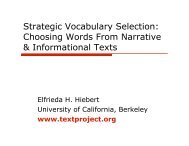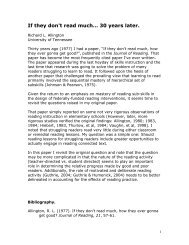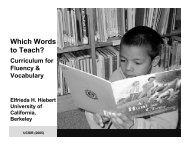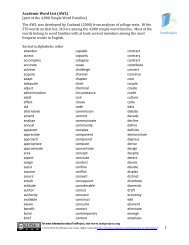Vocabulary Megaclusters - TextProject
Vocabulary Megaclusters - TextProject
Vocabulary Megaclusters - TextProject
Create successful ePaper yourself
Turn your PDF publications into a flip-book with our unique Google optimized e-Paper software.
Growing Capacity with the<strong>Vocabulary</strong> of English LanguageArts Programs:<strong>Vocabulary</strong> <strong>Megaclusters</strong>Elfrieda H. Hiebert<strong>TextProject</strong>, Inc.AbstractThe typical approach to teaching vocabulary in English/Language Arts programshas been to focus on six to eight words per text. Even though these words may addmeaning to a particular story, the target words are often rare and their generalizabilityis limited. The <strong>Vocabulary</strong> <strong>Megaclusters</strong> provides a framework for selectingand teaching words according to their shared meaning and function in stories.Within each of the 13 <strong>Vocabulary</strong> <strong>Megaclusters</strong>, words are clustered according toconceptual connections such as emotions and traits of characters or the actionsand motions in which characters engage. This article develops the rationale for the<strong>Vocabulary</strong> <strong>Megaclusters</strong> framework and illustrates how this approach providesstudents with a metacognitive stance that supports them in developing a rich literaryvocabulary.R E A D I N G R E S E A R C H R E P O R T # 1 1 . 0 2June 2011<strong>TextProject</strong>, Inc.SANTA CRUZ, CALIFORNIA
<strong>TextProject</strong> R E A D I N G R E S E A R C H R E P O R T #11.02ContentsIntroduction · · · · · · · · · · · · · · · · · · · · · · · · · · · · · · · · · · · · · · · · · · · · · · · · · · · · · · · · · · · · · · · · · · · · · · · · · · · · · · · · · · · · · · · · · · · · · · · · · · · · · · · · · · · · · · · · · · · · · · · · · · · · · · · · · · · · 1Rationale for the <strong>Vocabulary</strong> Megacluster Approach · · · · · · · · · · · · · · · · · · · · · · · · · · · · · · · · · · · · · · · · · · · · · · · · · · · · ·2Words in standards documents · · · · · · · · · · · · · · · · · · · · · · · · · · · · · · · · · · · · · · · · · · · · · · · · · · · · · · · · · · · · · · · · · · · · · · · · · · · · · · · · · · · · · · ·3TABLE 1 Ten Terms in ELA and Science Standards Documents at FourGrade Bands · · · · · · · · · · · · · · · · · · · · · · · · · · · · · · · · · · · · · · · · · · · · · · · · · · · · · · · · · · · · · · · · · · · · · · · · · · · · · · · · · · · · · · · · · · · · · · · · · · · · · · · · · · · · · · · · · · · · · · · · · · · ·3A comparison of vocabulary in ELA and content-area texts · · · · · · · · · · · · · · · · · · · · · · · · · · · · · · ·4An analysis of all unique words in an ELA program · · · · · · · · · · · · · · · · · · · · · · · · · · · · · · · · · · · · · · · · · · · · · ·4A Description of the <strong>Vocabulary</strong> Megacluster Approach · · · · · · · · · · · · · · · · · · · · · · · · · · · · · · · · · · · · · · · · · · · · ·5TABLE 2 WordZone Distribution of Entire, Unique, and Target <strong>Vocabulary</strong>:ELA Program · · · · · · · · · · · · · · · · · · · · · · · · · · · · · · · · · · · · · · · · · · · · · · · · · · · · · · · · · · · · · · · · · · · · · · · · · · · · · · · · · · · · · · · · · · · · · · · · · · · · · · · · · · · · · · · · · · · · · · · · · ·5Eliminating and collapsing of superclusters · · · · · · · · · · · · · · · · · · · · · · · · · · · · · · · · · · · · · · · · · · · · · · · · · · · · · · · · · · · · · · · 7Identification of <strong>Vocabulary</strong> <strong>Megaclusters</strong> · · · · · · · · · · · · · · · · · · · · · · · · · · · · · · · · · · · · · · · · · · · · · · · · · · · · · · · · · · · · · · · · · · 7TABLE 3 Contents of <strong>Vocabulary</strong> <strong>Megaclusters</strong> and Adapted Superclusters · · ·8Expanding and validating the database · · · · · · · · · · · · · · · · · · · · · · · · · · · · · · · · · · · · · · · · · · · · · · · · · · · · · · · · · · · · · · · · · · · · · · · ·8Application of the <strong>Vocabulary</strong> <strong>Megaclusters</strong> · · · · · · · · · · · · · · · · · · · · · · · · · · · · · · · · · · · · · · · · · · · · · · · · · · · · · · · · · · · · · · · · · · · · · ·9Shared <strong>Vocabulary</strong> <strong>Megaclusters</strong> · · · · · · · · · · · · · · · · · · · · · · · · · · · · · · · · · · · · · · · · · · · · · · · · · · · · · · · · · · · · · · · · · · · · · · · · · · · · · · · · · · · ·9TABLE 4 Distribution of <strong>Megaclusters</strong> Across Rare Words of an ELA Unit · · · ·9FIGURE 1 Example of <strong>Vocabulary</strong> from All Texts Within a Unit OrganizedAround a Single Megacluster · · · · · · · · · · · · · · · · · · · · · · · · · · · · · · · · · · · · · · · · · · · · · · · · · · · · · · · · · · · · · · · · · · · · · · · · · · · · · · · · · · · · · · · · · · 10Unique <strong>Vocabulary</strong> <strong>Megaclusters</strong> of individual texts · · · · · · · · · · · · · · · · · · · · · · · · · · · · · · · · · · · · · · · · · · · · 10FIGURE 2 Example of Selection of <strong>Megaclusters</strong> Based on Individual TextsWithin a Unit · · · · · · · · · · · · · · · · · · · · · · · · · · · · · · · · · · · · · · · · · · · · · · · · · · · · · · · · · · · · · · · · · · · · · · · · · · · · · · · · · · · · · · · · · · · · · · · · · · · · · · · · · · · · · · · · · · · · · · · ·11References · · · · · · · · · · · · · · · · · · · · · · · · · · · · · · · · · · · · · · · · · · · · · · · · · · · · · · · · · · · · · · · · · · · · · · · · · · · · · · · · · · · · · · · · · · · · · · · · · · · · · · · · · · · · · · · · · · · · · · · · · · · · · · · · · · · · · · 13iv
Growing Capacity with the <strong>Vocabulary</strong> ofEnglish Language Arts Programs:<strong>Vocabulary</strong> <strong>Megaclusters</strong>parlordraftfrostterrorfascinatedquainttimidetchedrumblingtropicalbiologistblufflagoonmassivecowardgleamedchorusshimmeringbrilliantforecastsinlandexpectedshatterdestructionsurgedanglepollinatewondrousfragrantpollencanopydappledslitheredThe words in the lists above are those identified for instructionwithin a unit of a widely used core reading program. For a five-week periodin the school lives of fourth-graders, this group of 33 words will providethe focus of vocabulary instruction. Are these the most critical words in thetext? Is the approximately 15 minutes of time devoted to each of these wordsover a five-week period the best use of the scarce instructional time in schools,especially for the students who depend on schools to overcome a huge gap inknowledge and vocabulary?Over the past decade, I have raised questions about the typical words chosenfor instruction within English Language Arts (ELA) programs, where themajority of elementary schoolchildren’s formal vocabulary guidance occurs(Hiebert, 2005; Nagy & Hiebert, 2010). My primary concern has been that theprocesses for selecting these words lack any apparent theoretical framework.The words are picked on a story-by-story basis, not on larger units of themesor semantic or morphological relatedness. Even within a story, such as VanAllsburg’s (1986) The Stranger (from which the first list of eight words come),reasons for the choices of particular words are not clear. In content areas, certainwords are employed because of their contributions to a theme. For example,if the words of focus in a science text are precipitation and condensation,the reader is able to anticipate the content. Experts often claim that it is impossibleto identify a set of words that coalesce within a narrative (Snow, Griffin, &Burns, 2005).On closer examination, however, words exist within The Stranger (and theother texts represented above) that are more semantically related than parlor
<strong>TextProject</strong> R E A D I N G R E S E A R C H R E P O R T #11.02and draft and that would lead to a richer interaction with the text. Three of thewords from the list do share a potential for connections to one another and tothe theme of the text: terror, timid, and fascinated. All three describe aspectsof the mysterious stranger who enters the life of the Bailey family: terror (thestranger’s initial response when hit by the truck), timid (when meeting the othermembers of the Bailey family), and fascinated (his response to seeing steamrising off of food). The text contains other words that further describe responsesof the stranger and that are likely to be less familiar but more relevant forvocabulary learning than words such as parlor and draft. The Baileys wonder ifthe stranger is a hermit. The stranger shyly tagged along. The weather becomesvery peculiar. The stranger is hypnotized by a flock of geese heading south. Hishand is trembling as he holds a green leaf from a tree and he becomes upsetabout the tree’s leaves. Connections could be drawn among these words, aswell as with some of the focus vocabulary (terror, timid, fascinated, quaint).By contrast, a concentration on parlor (a tangential reference to a place in theBailey home) is likely to divert attention from the magnetic pull of the strangerto nature and to his peculiar traits.A framework for categorizing the vocabularies of narratives is available, but ithas been understudied by researchers and underused in pedagogical projects.This framework is the semantic cluster approach (Marzano & Marzano, 1988).I have revisited the underlying constructs of this approach and have refinedit as the <strong>Vocabulary</strong> Megacluster approach. This article has three purposes:(a) an examination of why the <strong>Vocabulary</strong> Megacluster approach is essentialfor the development of the vocabulary of narratives, (b) an overview of the<strong>Vocabulary</strong> <strong>Megaclusters</strong>, and (c) an application of the <strong>Vocabulary</strong> Megaclusterapproach to the texts that were the source for the vocabulary that introducedthis chapter.2Rationale for the <strong>Vocabulary</strong> Megacluster ApproachRelatively few words in English account for a majority of the total words thatare read in text. In English, approximately 100 words account for almost 50% ofthe total words in text, and approximately 5,500 words account for 80% of thetotal words (Zeno, Ivens, Millard, & Duvvuri, 1995). Approximately 750,000words (Leech, Rayson, & Wilson, 2001) account for the remaining 20% of thewords in English texts. Most of the words within this last group appear lessthan once per one million (or even ten million) words.The common view is that words in informational texts dominate this last groupof rare words, not the words in narrative texts. While it is true that the vocabularyof informational texts challenges students, this vocabulary is challengingbecause it is conceptually complex, not necessarily because the words arerare. Narrative texts are actually more likely than informational texts to havea higher percentage of rare words. One of the reasons for this higher percentageis that the number of different rare words is higher in a narrative text. Arare word in an informational text will be repeated, as is the case in an article
<strong>Vocabulary</strong> <strong>Megaclusters</strong>on thermal energy with vocabulary such as convection and radiation. In a narrativeabout a stranger coming into a community, the author will likely use avariety of words to convey the reticence of the character (e.g., terror, fright,tremble), rather than repeating the same word over and over. As a result, narrativetexts are likely to have more unique rare words.These features of the vocabulary of narrative texts require an instructionalstance that recognizes these differences in kind and number of unique words. Ibring to bear three sources of evidence to illustrate the distinctive nature of thevocabulary of narrative text from that of informational text: (a) a comparisonof the words highlighted within standards documents for ELA and a contentarea (science), (b) the results of a study that compared the vocabulary identifiedfor instruction in ELA and science programs, and (c) an analysis of the focuswords that introduce this paper as well as of all the words in the texts fromwhich these words came.Words in standards documentsEvidence for a lack of theoretical or thematic purpose in the selection of wordsfor ELA programs comes from a summary of the vocabulary in standardsdocuments (Marzano, 2004). A list with ten terms from science and ELA vocabularylists for four different grade bands appears in Table 1. Even with an alphabeticlisting rather than a thematic one, it is evident that particular themesunderlie the science vocabulary, such as weather in grades K–2 (e.g., weatherpattern, precipitation, thermometer, weather conditions). This vocabularywould be expected to appear in texts or materials that students read and usefor inquiry.The ELA vocabulary is quite different. <strong>Vocabulary</strong> is represented that fits intoparticular groups that cut across grade levels, for instance, parts of speech (e.g.,adjective, common noun, relative pronoun). This vocabulary is likely to be partTABLE 1Ten Terms in ELA and Science Standards Documents at Four Grade BandsELAScienceLevel 1 (K–2)Level 2 (3–5)Level 3 (6–8)Level 4 (9–12)alphabet, back cover, consonant blend, folktale, longvowel, number word, purpose, sight word, textbook,vowel combinationadjective, common noun, contraction, essay, inference,motive, object, regular verb, tone, word choiceadverb phrase, business letter, comparative adjective,dialect, figure of speech, historical fiction, jargon,metaphor, relative pronoun, verb phraseacronym, censorship, denotative meaning, featurearticle, logographic system, mythology, past perfectverb tense, reflexive pronoun, structural analysis, visualtextair, daily weather pattern, energy, insect, mixture,precipitation, salt water, states of matter, thermometer,weather conditionsacceleration, conductivity, electrical current, friction,light emission, mass, omnivore, pollution, reproduction,volcanic eruptionasteroid, chemical element, eclipse, fungus,hydrosphere, lithosphere, muscular system, radiation,sunlight reflection, vertebratebiotic components of ecosystems, catalyst, electricpotential, genetic mutation, meiosis, ohm, particleemission, radioactive dating, semiconductor, torque,weight of subatomic particles3
<strong>TextProject</strong> R E A D I N G R E S E A R C H R E P O R T #11.02of teachers’ lessons or workbook exercises, but not in the narratives that comprisethe core reading programs commonly used in ELA instruction. It is highlyunlikely, for example, to find a narrative that uses any of the words that arelisted as the ELA vocabulary for grades 3–5 such as contraction or inference.A comparison of vocabulary in ELA and content-area textsA comparison of the words identified for instruction within the ELA and sciencetextbooks, fourth-grade programs, of the same publishers also illustratesthe qualities of literary vocabulary (Hiebert & Cervetti, 2011). For the ELAprogram, publishers had identified 209 words, seven from each selection, forthe focus of instruction and assessment. The 207 focus words in the scienceprogram were distributed across 19 lessons, each with an average of 11 words.Hiebert and Cervetti established six features of the 416 words: a) length ofwords; (b) predicted frequency per one million words of text (Zeno et al.,1995); (c) morphological frequency: the predicted frequency per one millionwords of text of the words transparently related to the focus word (Zeno et al.,1995); (d) familiarity (Biemiller, 2008; Dale & O’Rourke, 1976); (e) dispersion,which indicates how widely a word appears in different subject areas (Zeno etal., 1995); and (f) conceptual complexity (Hiebert & Cervetti, 2011).The features of words in narrative and informational texts were statisticallydifferent on all measures except for the frequency of morphological familiesof words and the dispersion index. On three of the remaining four features—length, familiarity, and conceptual complexity—the focus ELA words had averagesthat classed them as “easier” than the focus science words. On the fourthfeature, frequency, the ELA words were deemed harder than the science words,with an average frequency of 14 occurrences per one million words of texts forthe former and 39 for the latter. The target ELA words, then, were somewhatshorter, more familiar, and less conceptually complex than the target sciencevocabulary, but they were less frequent.4An analysis of all unique words in an ELA programA view of the vocabulary demands of narrative texts comes from an analysisthat identified the entire pool of words from which the focus words at thebeginning of this essay came. The analysis began with all 6,410 words in thefive texts of the focus unit (Afflerbach et al., 2007). Of these words, 1,204 wereunique or distinctive words.The frequency of these words was established through the WordZones Profiler(WZP; Hiebert, 2011) that draws on the Zeno et al. (1995) database. The eightword zones within the WZP differ according to the frequency with whichwords in a zone are predicted to occur in one million words of text. A smallgroup of words (930) make up zones 0–2. These words occur at least 100 ormore times per one million words of text. Approximately 4,900 words are inzones 3 and 4 where words are predicted to appear with moderate frequency(from 10 to 99 times per one million words). The approximately 8,240 words
<strong>Vocabulary</strong> <strong>Megaclusters</strong>TABLE 2WordZone Distribution of Entire, Unique, and Target <strong>Vocabulary</strong>: ELAProgramWordZonesTotal Words(n=6420)Unique Words33 Target <strong>Vocabulary</strong> Words(n=1240)proportion repetitions (X) proportion repetitions (X)0–2 .81 .50 8.3 0 NA3 .06 .15 2.1 .09 2.34 .09 .15 1.9 .27 1.45 .02 .13 2.0 .42 2.16 .01 .03 1.3 .15 17 .02 .04 2.6 .06 1that make up zone five are relatively rare (2 to 9 appearances per one millionwords). A group of approximately 5,650 words occur about once per one millionwords and make up zone six. The remaining words fall in zone seven andoccur less than once per one million (approximately 135,475 words in the Zenoet al. analysis of a 17.25-million-word corpus).The distribution of the unique words in the five texts into the word zones appearsin Table 2. It is the words of zones 5 and 6 that vocabulary instructionwill likely emphasize since students are unlikely to have encountered thesewords previously in text. Words in zones 0–4 are ones which fourth-gradersshould know since these are words that are used frequently in their texts. Ofthe words chosen for instruction, approximately 63% were rare words. Most ofthese words appear once in the entire unit. Another 24% appeared 2–3 times.The remaining 10% appeared 4 times or more. Only 2% of this group appearedthe requisite 10 times or more. The 33 words that introduced this essay representapproximately 5% of the rare/moderate words in the texts.What can be concluded from this analysis is that there are numerous single-appearingwords in narrative texts that appear infrequently in written language asa whole. It would be impossible for teachers to cover all of the words in lessons,even for a single text. Further, since the words can be exceedingly diverse inmeaning, the instructional approach and task would be arduous. Finally, sincealmost all of these rare words appear infrequently in the text and are unlikelyto reappear again in the texts that students are reading in other content areas,the longevity of students’ learning—even of words that are taught intensivelybut appear a single time in a text—is uncertain.A Description of the <strong>Vocabulary</strong> Megacluster ApproachNarratives have particular features, most notably a setting, problem, goal, action,outcome, resolution, and theme (Stein & Glenn, 1979; Whaley, 1981). Thestructure of narratives, as Bruner argued (1990), mirrors the way in which hu-5
<strong>TextProject</strong> R E A D I N G R E S E A R C H R E P O R T #11.026man beings describe their life experiences. Narratives are familiar structuresand, typically, accessible to students. Within the instructional applicationsof story structure to the interpretation of texts, as Duke and Pearson (2002)showed, the structural aspects of text organization are emphasized rather thanthe concepts represented by these features of narrative. Students are taught toidentify the particular components rather than to identify evidence within thetext. The elements of stories were taught as structures rather than as conceptsrepresented by ideas or words.In a conceptual, rather than structural, approach to narratives, students learnto expect that characters will be involved in actions to deal with problems orconflicts. Authors use a variety of words to label the characters, the actions,the events, and the particular contexts in which these events occur. It is likelyimpossible to predict the words that an author will use in a narrative. For example,it is rare that a writer of a mystery will use the words suspense or evenmystery. The words used by an author to describe a particular trait may varyfrom sentence to sentence but there are likely to be words that describe thetraits and emotions of characters. These words can be clustered into categoriesthat share particular meanings. Students can be taught to anticipate that authorswill use words to describe the various components of the narrative. It isin this anticipation—or a meta-linguistic awareness—that vocabulary developmentcan occur.The basis for a categorization scheme for the primary concepts of narrativesand expository content can be found in a 1998 publication by Marzano andMarzano. They presented a categorization of 7,230 words taken from a numberof sources common in elementary school texts (e.g., Carroll, Davies, &Richman, 1971; Dahl, 1979; Harris & Jacobson, 1972). Marzano and Marzanoordered these words into 61 superclusters that were semantically related.One of the most prolific superclusters that they identified was occupations ofpeople. All 364 words that they assigned to that supercluster had to do withoccupations of people, but those words were further categorized into clustersof words even more closely aligned. The supercluster of occupations contained30 clusters, each pertaining to a different type of job such as people in sports,entertainers, and royalty/statesmen. Words within clusters were further organizedinto miniclusters. For example, within the entertainers cluster, miniclustersinclude actress, clown, and entertainer. Each of the miniclusters has atleast a handful of words, sometimes more. The minicluster of clown consistsof: clown, barker, magician, comic, and juggler. In all, Marzano and Marzanoidentified 430 clusters within the 61 superclusters and, within the clusters, 1,500miniclusters where words have the strongest semantic ties.The Marzano and Marzano (1988) clusters were published just when attentionin reading education moved to the “whole text.” Extensions of and experimentationwith the clusters have been limited. These clusters, however, provide ameans for much-needed support for the selection and instruction of vocabularythat Nagy and Hiebert (2010) have described. In particular, the cluster
<strong>Vocabulary</strong> <strong>Megaclusters</strong>approach may provide considerable guidance to publishers and curriculumdevelopers regarding the many unique words in narrative texts that lack thethematic cohesiveness typically present in content-area texts and instruction.For the cluster system to be useful to educators in selecting words for instruction,however, the system needs refinement. For one, the system needs to beable to integrate words from additional sources, such as the trade books thathave become the basis for core reading programs. For such expansion, the superclustersthemselves need to be defined and understood as conceptual sourcesof content. Another aspect of the superclusters that makes their use less thanconceptual is the system’s organization. Marzano and Marzano presented thesuperclusters in order of size (e.g., occupations first, types of motion next, andso on). The number of clusters—61—is also unwieldy.To enable teachers and publishers to select the words to teach more efficiently,I have reconfigured the superclusters into 13 megaclusters, each of which representsa “big idea” about the content of texts. The development of the 13 megaclustersinvolved two steps: (a) eliminating and collapsing the superclustersand (b) identifying megaclusters from among the superclusters.Eliminating and collapsing of superclustersA first step was to eliminate a group of superclusters devoted to grammar:Pronouns, Contractions, and Auxiliary/helping verbs. The reason for this eliminationis that the focus of the <strong>Vocabulary</strong> <strong>Megaclusters</strong> is on the conceptualcontent of words and the grammatical functions do not serve that purpose.Subsequent changes to the remaining 58 superclusters are presented in Table 3.These changes involved collapsing several superclusters into related superclusters:(a) Health/disease was integrated into Human body, (b) an overall superclusterentitled Action was created from Helpful/destructive actions, Touching/grabbing actions, and Actions involving the legs, and (c) Noises/sounds andFacial expressions/actions were added to Communication, leaving 53 superclusters.Identification of <strong>Vocabulary</strong> <strong>Megaclusters</strong>The remaining 53 superclusters were examined with the aim of emphasizingparticular components of narrative and expository texts. Many different perspectivescould be brought to bear on the designations—just as is true withthe original designations by Marzano and Marzano (1988). The final set of 13megaclusters was derived from the primary components of narrative texts(Stein & Glenn, 1979; Whaley, 1981).It should be noted that the integrity of the superclusters has been retained.Within the database, vocabulary can still be viewed in relation to superclusters,clusters, and miniclusters where the greatest similarity exists. For example,while Occupations, Types of people, and Types of groups form the megaclusterof Characters, the data on the supercluster of Occupations continue to be7
<strong>TextProject</strong> R E A D I N G R E S E A R C H R E P O R T #11.02distinguished from the superclusters of Types of people and Types of groups.Researchers and educators working with the database can continue to identifythe words in the closest possible grouping.Expanding and validating the databaseThe database, initiated with the original words designated by superclusters,clusters, and miniclusters, has been extended to approximately 8,500 words.New words being added to the vocabulary corpus undergo a vetting process.First, the synonyms of a word are identified and a rater experienced in thesemantic clustering procedures identifies a match to a particular minicluster,cluster, supercluster, and megacluster. Periodically, a second rater, also experiencedin semantic clustering, independently categorizes the words thathave been added to the database. When disagreements between raters arise,the nature of the disagreements and their resolution are recorded. After every350 new additions to the database, a third experienced rater examines 20% ofthe additions as well as a randomly selected set of words that were part of theoriginal database to ensure the fidelity of categorizations.TABLE 3Contents of <strong>Vocabulary</strong> <strong>Megaclusters</strong> and Adapted Superclusters<strong>Vocabulary</strong> Megacluster Superclusters (in Original Marzano & Marzano, 1988) Changes from Original Superclusters8I. EMOTIONS & ATTITUDES Feelings/emotion; AttitudinalsII. COMMUNICATION Communication; Mental actions; Senses/perceptions (Communication subsumes Facial expressions/actions & Noises/sounds)III. TRAITS OF CHARACTERS Nonemotional traits; Physical traits of peopleIV. SOCIAL RELATIONSHIPS Ownership/possession; Popularity/knownness; Life/survival;Conformity/complexityV. CHARACTERS Occupations; Types of people; Types of groupsVI. ACTION & MOTION Action; Motion (Action subsumes Touching/grabbing, Actionsinvolving legs, Helpful/destructive actions)VII. HUMAN BODY Human body; Clothing (Human body subsumes Health/disease)VIII. FEATURES OF EVENTS/THINGS/PEOPLEValue/correctness; Similarity/dissimilarity;Cleanliness/uncleanliness; Difficulty/danger; CausalityIX. PLACES/EVENTS Places where people live; Dwellings/shelter;Rooms/furnishings; EventsX. PHYSICAL ATTRIBUTES OFTHINGS/EVENT/EXPERIENCESize/quantity; Time; Location/direction; Shapes/dimensions;Texture/durability; ColorXI. NATURAL ENVIRONMENT Animals; Foods; Water/liquids; Land/terrain; Vegetation;Soil/metal/rock; Light; Weather; Mathematics;Temperature/fire; Chemicals; ElectricityXII. MACHINES Machines/engines/tools; Transportation; MaterialsXIII. SOCIAL SYSTEMSLiterature/writing; Money/finance; Sports/recreation;Language; Entertainment/arts
<strong>Vocabulary</strong> <strong>Megaclusters</strong>TABLE 4Distribution of <strong>Megaclusters</strong> Across Rare Words of an ELA UnitMegacluster Examples Narrative• Communication summoned, shrieked .11• Emotions & Attitudes anticipation, expected .04• Traits of Characters daring, dignified .02• Social Relationships peculiar, free .03• Characters (Occupations, People, Groups) duke, magician .06• Action & Motion dangled, swatted .15• Comparatives/Values identical; useless .04• Body & Health muscles, vaccine .03• Places/Dwellings homeland; mansion .04• Physical Attributes massive .10• Nature precipitation, sedimentary .26• Machines pulley, vehicle .07• Social Systems sculptures, payroll .05To determine how well the <strong>Vocabulary</strong> <strong>Megaclusters</strong> accounted for the newlyadded vocabulary, words that had been identified as rare in Table 2 (i.e., the149 that appeared in WordZones 5 and 6 in the ELA unit) were examined inrelation to the <strong>Vocabulary</strong> <strong>Megaclusters</strong> database. The summary of this classificationis given in Table 4. A <strong>Vocabulary</strong> Megacluster that is also common toinformational texts—Nature—had the largest corpus of words. Since two of thefive texts in the unit are magazine articles that have both narrative and informationalelements, the appearance of words having to do with nature is understandable.As would be expected of narrative text, the <strong>Vocabulary</strong> <strong>Megaclusters</strong>of Communication and Action were also heavily represented.Application of the <strong>Vocabulary</strong> <strong>Megaclusters</strong>How might the information about <strong>Vocabulary</strong> <strong>Megaclusters</strong> be used byteachers? I offer two potential routes for a “conceptual” approach to narrative:(a) shared <strong>Vocabulary</strong> <strong>Megaclusters</strong> across a set of texts and (b) unique<strong>Vocabulary</strong> <strong>Megaclusters</strong> as a function of the author’s use of language in a specifictext.Shared <strong>Vocabulary</strong> <strong>Megaclusters</strong><strong>Vocabulary</strong> that is typically critical in a narrative has to do with the ways inwhich characters communicate and with the characters’ emotions and attitudes.<strong>Vocabulary</strong> associated with these critical aspects of narratives couldbe developed with particular clusterings of texts and also could be a focus ofinstruction in different grades. Emotions of fear, joy, and anger, for example,9
<strong>TextProject</strong> R E A D I N G R E S E A R C H R E P O R T #11.02FIGURE 1Example of <strong>Vocabulary</strong> from All Texts Within a Unit Organized Around aSingle Megaclusterwould be represented by larger and richer vocabularies through the grades,with the vocabulary of narratives read in earlier grades becoming the foundationfor expanding and enriching the vocabulary related to a concept in latergrades.In the particular set of texts that formed the focus unit, the emotion of fear waspresent in four of the five texts. In Adelina’s Whales (Sobol, 2003), Adelina’sgrandfather is frightened. In The Stranger (Van Allsburg, 1986), the strangeris filled with terror, and in How Night Came From the Sea (Gerson, 1994), theservants are terrified. In Eyes of the Storm (Kramer, 1997), Warren (the stormchaser) describes how the situation is getting scarier and scarier. The wordsused in the texts are the basis for a semantic map that appears in Figure 1.The number of synonyms and semantically related words for this concept isenormous. A recommendation that Nagy and Hiebert (2010) have made is forteachers to guide students’ attention to a core set of words and then, gradually,to examine the semantic map. If too many words are introduced at once, studentsmay have difficulty establishing the nuances of meanings.10Unique <strong>Vocabulary</strong> <strong>Megaclusters</strong> of individual textsBy examining the unique megaclusters represented in each of the five texts inthis unit, I was able to identify possible emphases for the instruction of vo-
<strong>Vocabulary</strong> <strong>Megaclusters</strong>cabulary in each text. The uniqueness of each of the texts is represented in thesemantic map in Figure 2.In the two narratives—How Night Came From the Sea (Gerson, 1994) and TheGreat Kapok Tree (Cherry, 1990)—language is used richly and uniquely. HowNight Came From the Sea has an array of adjectives that are used to describethe brightness of the light, which is new and jarring for the unnamed womanin the story. For the night—which represents the woman’s previous experiences—theauthor uses numerous metaphors. A teacher could initiate an interestingconversation as to whether there are descriptions for darkness of thesame variety as those for brightness, or whether metaphors are typically usedto describe darkness and night.FIGURE 2Example of Selection of <strong>Megaclusters</strong> Based on Individual Texts Within a Unit11
<strong>TextProject</strong> R E A D I N G R E S E A R C H R E P O R T #11.02The two magazine articles—Adelina’s Whales and Eyes of the Storm—use differentwords from those in the narratives. But there are, in addition, significantdifferences in the ways that the authors employ language. For example, the vocabularyof Adelina’s Whales is fairly straightforward, as might be expected ina magazine article, with one exception: the actions of the whales (e.g., fluking,spyhopping, breaching). The author’s choice of these less common words allowsfor a discussion of how compound words are created (such as spyhopping) andthe nature of old Anglo-Saxon words (fluke, breach).One could even imagine a set of texts chosen because they illustrate ways inwhich authors use language to express various contexts. London’s (1906/2010)White Fang and Paulsen’s (1987) Hatchet could be compared for their representationsof adventure and danger. Erdich’s (2002) The Birchbark Tree could bediscussed with O’Dell’s (1960) Island of the Blue Dolphins to understand howdifferent authors might communicate despair, hope, and human ingenuity.The current instructional approach of focusing on six to eight disparate wordsover a week does little to develop a strategic stance on the part of students. Ifstudents are to develop a deep understanding of vocabulary in literary texts,instruction needs to uncover the underlying uses of language in narratives.The <strong>Vocabulary</strong> <strong>Megaclusters</strong> provide a framework for teachers, publishers,and curriculum developers to select vocabulary and design instruction aroundcritical concepts within narratives. By focusing on principles of language ratherthan only on the individual word, students gain the generative stance that isneeded to engage in lifelong expansion of vocabulary.12
<strong>Vocabulary</strong> <strong>Megaclusters</strong>ReferencesAfflerbach, P., Blachowicz, C.L.Z., Boyd, C.D., Cheyney, W.,Juel, C., Kame’enui, E.J., Leu, D.J., Paratore, J.R., Pearson,P.D., Sebasta, S.L., Simmons, D., Vaughn, S., Watts-Taffe, S.,& Wixson, K.K. (2007). Reading Street. Glenview, IL: ScottForesman.Biemiller, A. (2008). Words worth teaching. Columbus, OH:SRA/McGraw-Hill.Bruner, J. (1990). Acts of meaning. Cambridge, MA: HarvardUniversity Press.Carroll, J., Davies, P., & Richman, B. (1971). The Americanheritage word frequency book. Boston, MA: HoughtonMifflin.Cherry, L. (1990). The Great Kapok Tree: A Tale of theAmazon Rain Forest. New York, NY: Harcourt, Inc.Dahl, H. (1979). Word frequencies of spoken AmericanEnglish. Essex, CT: Verbatim.Dale, D., & O’Rourke, J. (1976). The living word vocabulary.Elgin, IL: Field Enterprises Educational Corporation.Duke, N.K., & & Pearson, P.D. (2002). Effective practice fordeveloping reading comprehension. In A.E. Farstrup & S.J.Samuels (Eds.), What research has to say about reading instruction(3rd Ed., pp. 205–260). Newark, DE: InternationalReading Association.Erdich, L. (2002). The Birchbark House. New York, NY:Hyperion Press.Gerson, M.J. 91994). How night came from the sea. NewYork, NY: Little Brown & Co.Harris, A., & Jacobson, M. (1972). Basic elementary readingvocabularies. New York, NY: Macmillan.Hiebert, E.H. (2011). WordZones Profiler. Santa Cruz, CA:<strong>TextProject</strong>.Hiebert, E.H. (2005). In pursuit of an effective, efficientvocabulary curriculum for the elementary grades. In E.H.Hiebert & M. Kamil (Eds.), The teaching and learning ofvocabulary: Bringing scientific research to practice (pp. 243–263). Mahwah, NJ: LEA.Hiebert, E.H., & Cervetti, G.N. (2011). What differences innarrative and informational texts mean for the learning andinstruction of vocabulary (Reading Research Report 11.01).Santa Cruz, CA: <strong>TextProject</strong>.Kramer, S. (1997). Eye of the storm. New York, NY: PenguinYoung Readers Group.Leech, G., Rayson, P., & Wilson, A. (2001). Word frequenciesin written and spoken English based on The British NationalCorpus. London: Longman.London, J. (1906/2010). White Fang. New York, NY: Simon& Brown.Marzano, R. J. (2004). Building background knowledge foracademic achievement. Alexandria, VA: Association forSupervision and Curriculum Development.Marzano, R. J., & Marzano, J. S. (1988). A cluster approachto elementary vocabulary instruction. Newark, DE:International Reading Association.Nagy, W.E., Hiebert, E.H., (2010). Toward a theory of wordselection. In M.L. Kamil, P.D. Pearson, E.B. Moje, & P.P.Afflerbach (Eds.), Handbook of Reading Research (Vol. 4; pp.388–404). New York, NY: Longman.O’Dell, S. (1960). Island of the blue dolphins. Boston, MA:Houghton Mifflin.Paulsen, G. (1987). Hatchet. New York, NY: Simon &Schuster Children’s Publishing.Snow, C.E., Griffin, P., & Burns, M.S. (Eds.) (2005).Knowledge to support the teaching of reading: Preparingteachers for a changing world. San Francisco, CA: Jossey-Bass.Sobol, R. (2003). Adelina’s whales. New York, NY: DuttonChildren’s Books.Stein, N. L., & Glenn, C.G. (1979). An analysis of story comprehensionin elementary school children. In R.O. Freedle(Ed.), Advances in discourse processes (Vol. 2, pp. 53–120).Norwood, NJ: Ablex.Van Allsburg, C. (1986). The stranger. Boston, MA:Houghton Mifflin Books for Children.Whaley, J.F. (1981). Readers’ expectations for story structure.Reading Research Quarterly, 17(1), 90–114.Zeno, S. M., Ivens, S. H., Millard, R. T., & Duvvuri, R.(1995). The educator’s word frequency guide. New York, NY:Touchstone Applied Science Associates.13
<strong>TextProject</strong>, Inc. is a non-profit public benefitcorporation. Its aim is to bring beginning andstruggling readers (of any age) to high levels ofliteracy through a variety of strategies and tools,particularly the texts used for reading instruction.Find out more at textproject.orgE d i t o r i a l B o a r d f o r Te x t P r o j e c t , I n c . P u b l i c a t i o n sMartha AdlerUniversity of Michigan, DearbornVictoria AppatovaUniversity of CincinnatiKathie BachApex LearningSuzanne BarchersStanford, CAAlison BillmanLawrence Hall of Science/University of California, BerkeleyMarco BravoSanta Clara UniversityDevon BrennerMississippi State UniversityJanelle CherringtonScholasticJanet GaffneyUniversity of Illinois,Champaign-UrbanaRobert GaskinsBenchmark SchoolShannon HendersonUniversity of Arkansas, Little RockHeather KoonsMetametricsMelanie KuhnBoston UniversityPamela MasonHarvard UniversityShailaja MenonJones International UniversityHeidi Anne MesmerVirginia TechMaria MurraySUNY-OswegoColleen Klein ReutebuchUniversity of Texas, AustinPaula SchwanenflugelUniversity of GeorgiaAlexandra SpichtigReading PlusGuy TraininUniversity of Nebraska, LincolnMasa UzicaninWireless GenerationClaire WhiteHarvard UniversityKathy WilsonUniversity of Nebraska, Lincoln





